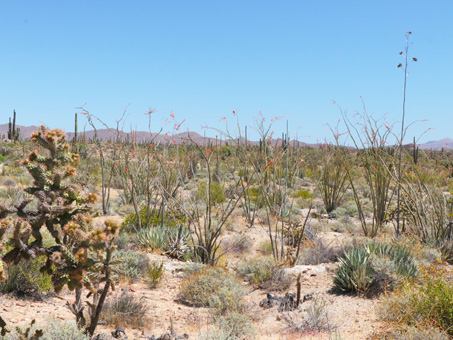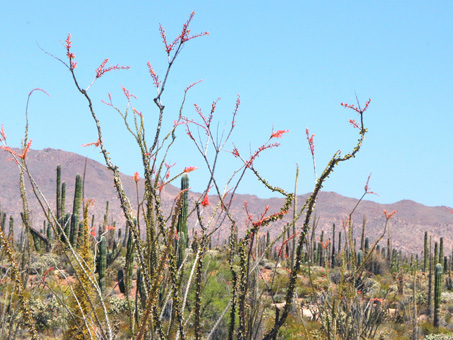BEE SEP 2020
Homeward Bound (Part 2)— May 2020
 In this month's entry, I continue with the last leg of our trip northward within Mexico. We start in the Central Desert around Km 249 just south of Laguna Chapala, turn onto Hwy 5 at Laguna Chapala and head northeastward across the peninsula to the Gulf of California then north along the coast to San Felipe, and finally through the Colorado River delta to the international border at Mexicali. The route to the border via Hwy 5 is shorter, and for us, can be done with just one overnight stop (Guerrero Negro to San Felipe). It has less traffic and in this time of coronavirus, we felt we would be much more likely to encounter fewer people and have a lower risk of contact with them. Onward...
In this month's entry, I continue with the last leg of our trip northward within Mexico. We start in the Central Desert around Km 249 just south of Laguna Chapala, turn onto Hwy 5 at Laguna Chapala and head northeastward across the peninsula to the Gulf of California then north along the coast to San Felipe, and finally through the Colorado River delta to the international border at Mexicali. The route to the border via Hwy 5 is shorter, and for us, can be done with just one overnight stop (Guerrero Negro to San Felipe). It has less traffic and in this time of coronavirus, we felt we would be much more likely to encounter fewer people and have a lower risk of contact with them. Onward...
Hwy 1 — Km 249 just south of Laguna Chapala
This stop just off the highway is located 6 km south of the Cuesta El Portezuelo, a grade which, according to Minch et al. (1998) marks "the main peninsular divide...where the highway passes east of a ridge between the Pacific drainage and the gulf drainage" [1].
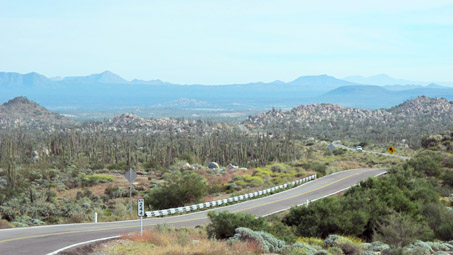
The view from near the top of the Portezuelo grade, looking southeast towards the sweeping valley below and the Sierra la Asamblea beyond, is spectacular. The region is located within the Valle de los Cirios Protected Area.

The Sierra la Asamblea is located to the east of the highway. Its highest point is described by Minch et al. (1998) as a granitic pluton surrounded by darker metamorphic rocks, with several light-colored dikes cutting through them. The range can be seen in the background in many of the images in this section.
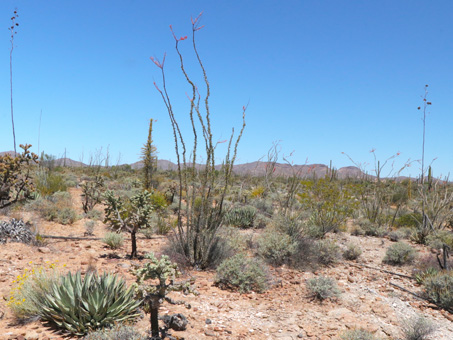
One of my favorite places to pull over in this immense bajada region of the Central Desert. Botanical gardens strive for this look! In the 30 minutes we spent wandering, I recorded at least 39 different taxa in a 50 meter radius.
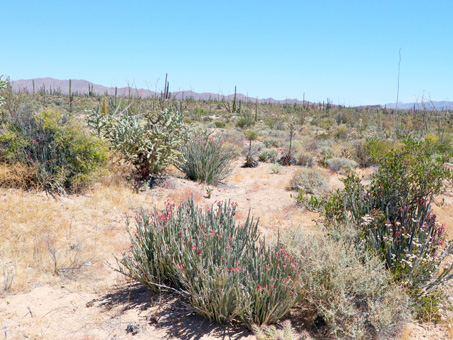
Lots of space between plants and between small clusters of plants. In the foreground counterclockwise from L are Slipper or Wax plant (Euphorbia lomelii), Four-wing Saltbush (Atriplex canescens var. canescens), Baja California Buckwheat (Eriogonum fasciculatum var. flavoviride), more Slipper plant and Jojoba (Simmondsia chinensis). All are natives.
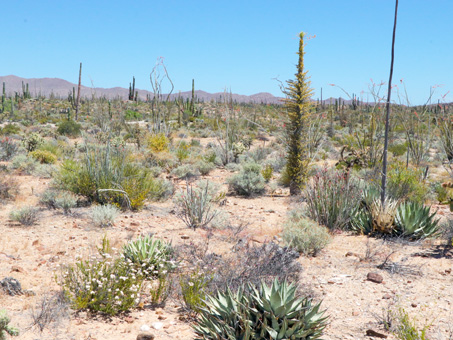
A mixture of plants both in bloom and past their prime. Buckwheat in the foreground with Desert Agave (Agave desertii). There were a lot of yellow leaves, including on the large erect Boojum Tree at center (Fouquieria columnaris). while other yellow patches are from some blooming sunflower species.
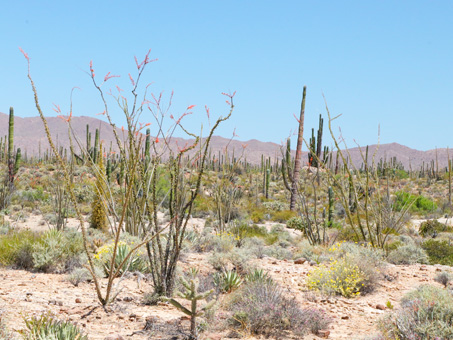
The Ocotillo (Fouquieria splendens) were sending out plenty of red flowers on their flame-like inflorescences.

More Slipper Plant in full bloom.
Just a Few of the Species Present

Chain-link Cholla (Cylindropuntia cholla) and Slipper Plant.
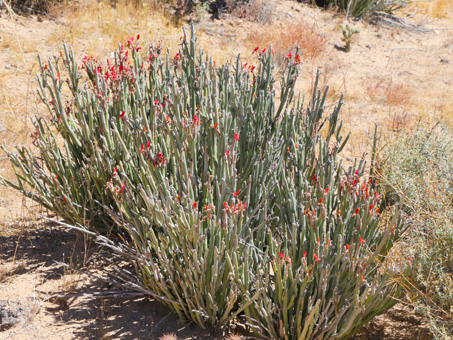
All of the Slipper Plants were especially colorful with their red flowers and/or capsules. They look like they have flames coming out of their tips.
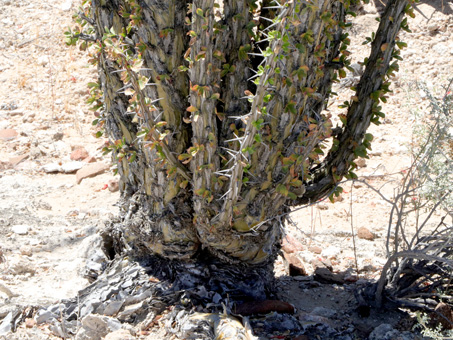
Base of an Ocotillo, showing the lack of a defined trunk.
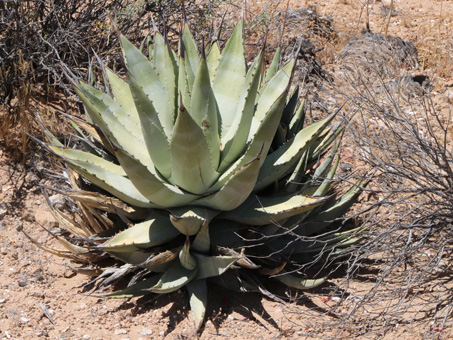
Desert Agave (Agave desertii subsp. deserti). This is a rather small species of Agave, but it may occur in large clusters of rosettes. The entire rosette ranges from 30-70 cm H x 40-80 cm D. Closer to the Pacific in this same region, Coastal Agave (A. shawii) is a robust giant by comparison, reaching 1-2 m H x D.

White Ratany (Krameria bicolor). Like other peninsular species of Krameria, the flowers are fragrant and visited by “oil” bees.
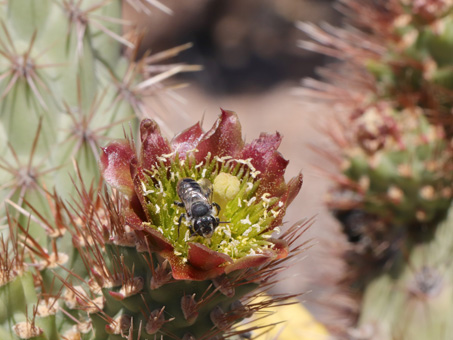
Cholla barbona (Cylindropuntia alcahes var. alcahes). The flowers on this "bearded" species are quite variable, ranging from this dark red to a yellow or yellowish green, clear or tinged with red.
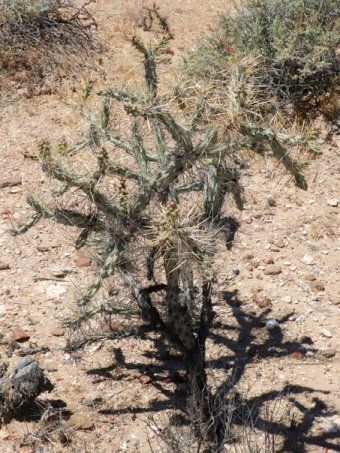
Long-Spine Cholla (C. molesta var. molesta), one of the five cholla taxa we found in this small area. The others are not pictured here, but click on the following links to see C. ganderi var. catavinensis and C. tesajo from previous sightings nearby. Chain-Link Cholla is pictured in a photo above.
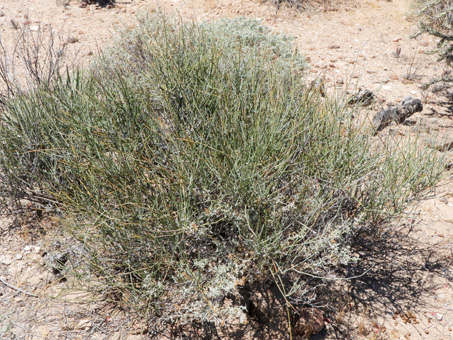
Mormon-Tea / Cañatillo (Ephedra aspera) and White Bur-sage (Ambrosia dumosa).
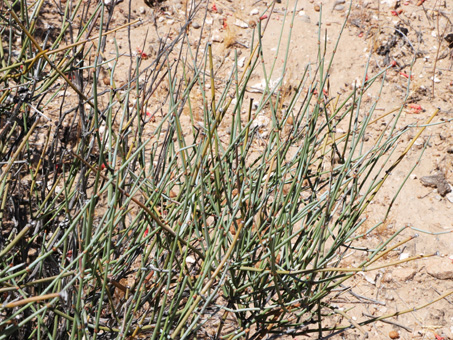
Mormon Tea / Cañatillo.
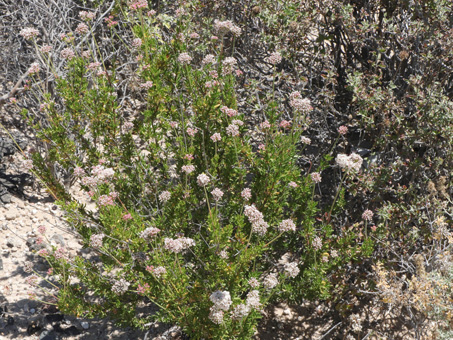
Baja California Buckwheat (Eriogonum fasciculatum var. flavoviride).
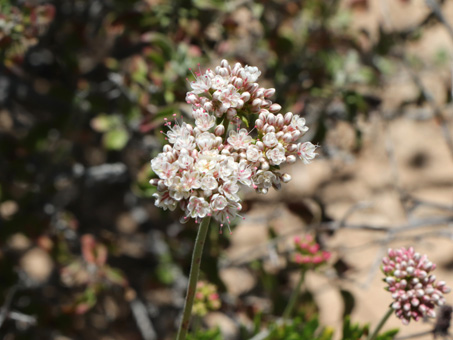
Flowers of Baja California Buckwheat. White, tinged pink. Pinkish in the bud.
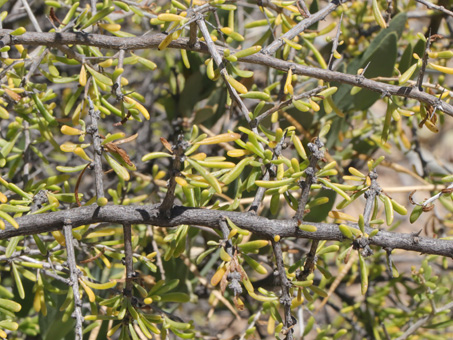
The succulent leaves of California Desert Thorn/Frutilla (Lycium californicum var. californicum, Solanaceae). The tiny flowers are white.
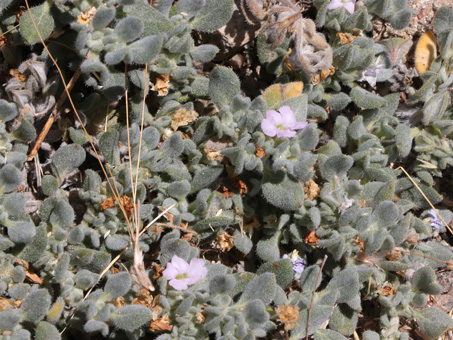
Woody Crinklemat (Tiquilia canescens var. canescens, Ehretiaceae [Boraginaceae] [2]). This is a small, prostrate shrub. Flowers are pale pink, lavender or white and about 5 mm D. Leaves are furry.
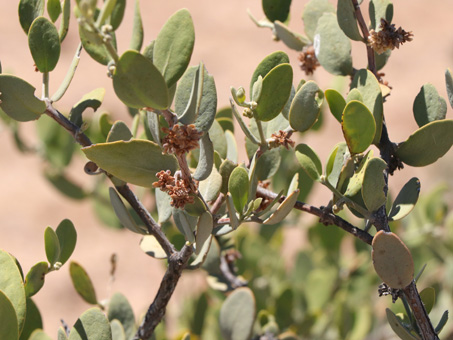
Jojoba (Simmondsia chinensis, Simmondsiaceae). This is a staminate plant. The dried up stamens, found in glomerules, can be seen here. The leaves are leathery and usually vertically oriented to minimize sun exposure in their arid environment. See the pistillate flowers and fruit from a Mulegé plant.
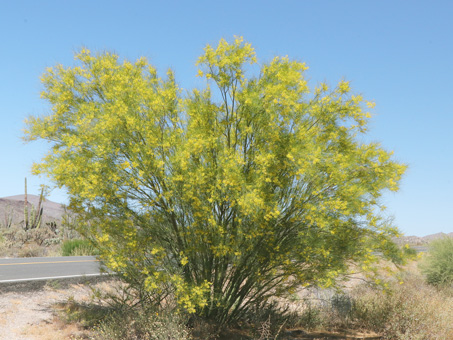
Mexican Palo Verde (Parkinsonia aculeata, Fabaceae) in bloom. In Mulegé, this tree grows mostly along the river and in the palm oasis, so it seems odd to see these trees throughout the extremely arid regions of the central peninsula far from water.
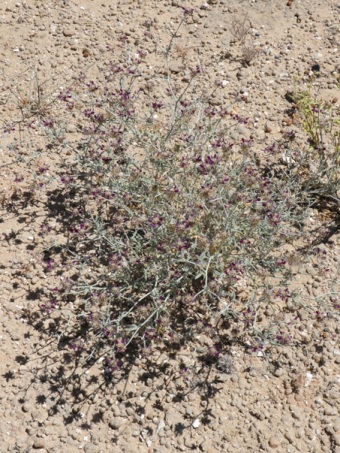
Dye Bush / White Dalea (Psorothamnus emoryi var. emoryi, Fabaceae). This is a common native perennial in the Central Desert. It reaches its southern boundary around Mulege, where it occurs only on coastal dunes.
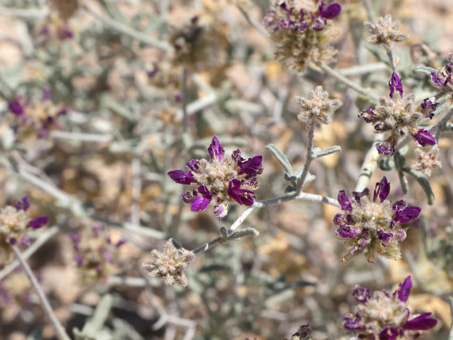
Dye Bush is well-adapted to desert living: densely hairy, gray-green herbage; and stems forming an open, rounded mound with interlacing branches. The inflorescences are about 1 cm D.
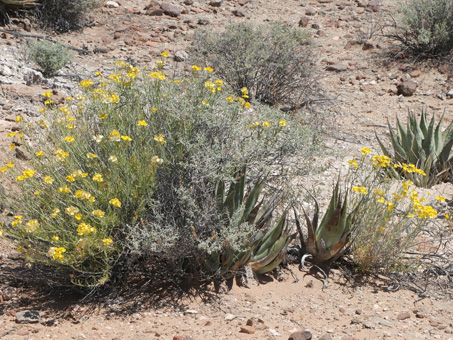
L to R: Paper-Daisy (Psilostrophe cooperi, Asteraceae), White Bur-Sage / Burrobush and Desert Agave.
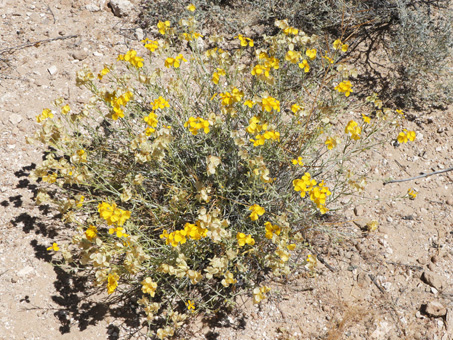
Paper-Daisy. I've only ever seen this species in the Central Desert in this region, from around Punta Prieta northward to Cataviña. The low rounded bush is a vibrant yellow and one of the few species in full bloom when we pass by, most often in May.
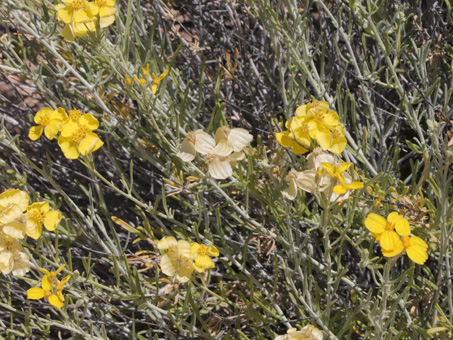
The plant is usually cespitose, with open branches. It is densely tomentose with white to gray-green stems and leaves that are small.
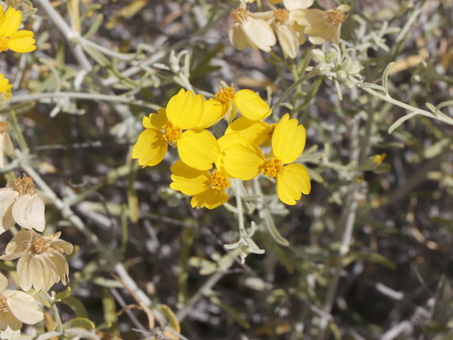
The old ray flowers (ligules) fade and become papery; they are tough & persist for some time. Here, each ray is about 1.5 cm L.
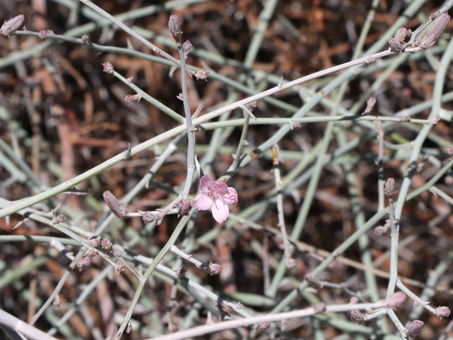
Wire-Lettuce (possibly Stephanomeria pauciflora, Asteraceae). Yet another openly-branched, gray-green perennial with few small leaves.
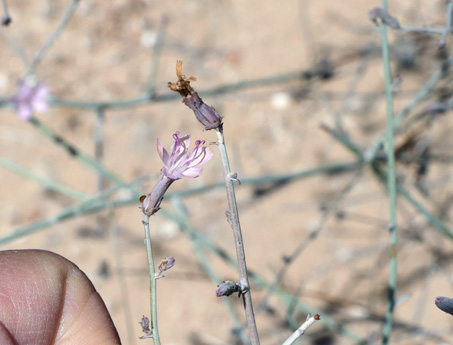
The plant was so pale and wispy that I almost walked right over it, blinded as I was by the midday sun. Like many species in the tribe Chicoriae, it has a milky sap. The flowers are about 1 cm D.
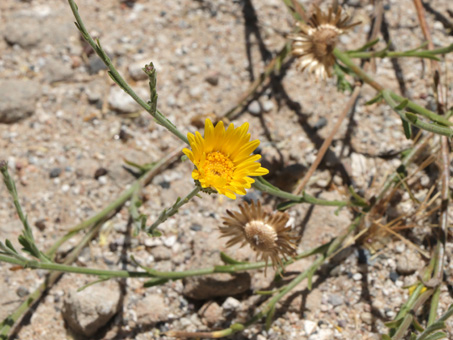
Likely Xanthisma scabrellum (Peninsular Tansy-Aster/Cola de Zorra, Asteraceae). This is an endemic species.
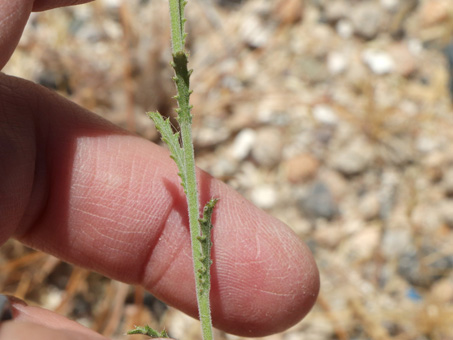
It occurs from the Sierra Asamblea in c BC (not far N of this location) all the way to the Cape region. Look at those tiny, toothed leaves.
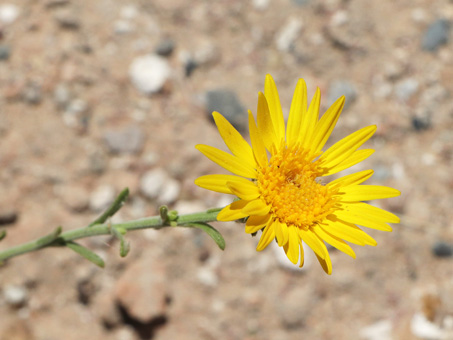
Peninsular Tansy-aster. The capitulum is about 2-2.5 cm D.
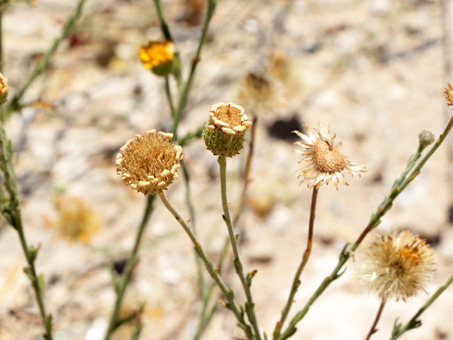
Peninsular Tansy-aster going and gone to "seed".
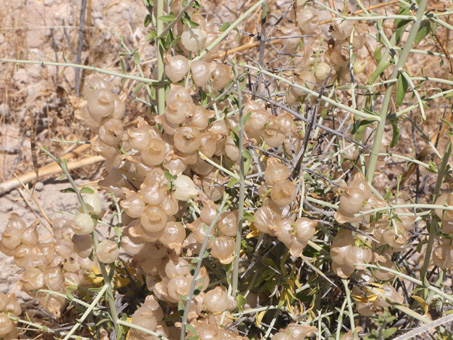
Probably one of the weirder desert plants. These are the inflated calyces of Bladder-Sage (Scutellaria mexicana, Lamiaceae). Also known as Paper Bag Bush!
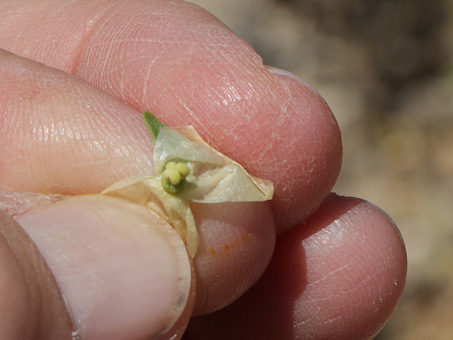
The flowers were done, but this is the tiny 4-lobed ovary inside the calyx with its two-headed stigma. See more photos of this species.
Hwy 5 — Laguna Chapala to Mexicali, Km 200
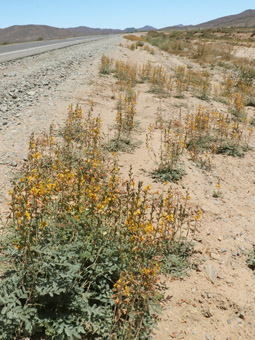
Pig-Nut or Hog-Potato, a native perennial
(Hoffmannseggia glauca, Fabaceae)
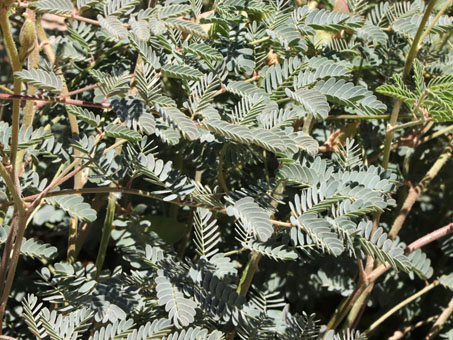
Leaves of Pig-Nut. It occurs from far northern BC south to the Tres Vírgenes region. It is commonly seen in large colonies as a roadside weed, as in the previous photo.
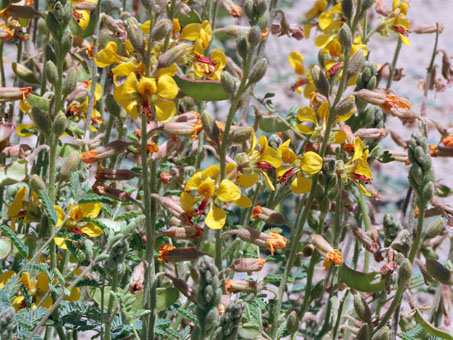
Pig-Nut flowers and fruit pods. These were especially tall specimens, a little over 30 cm. Most plants I've seen in the past were barely 15 cm H.
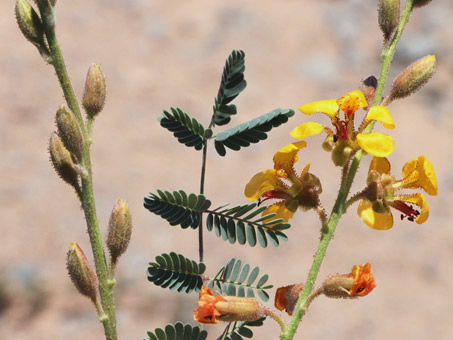
Flowers of Pig-Nut. Like relatives in the genus Casaelpinia, the corollas have dark oil glands on their outer surfaces, as well as on the calyces and other parts of the inflorescence.
Hwy 5 - Km 164 — Arroyo las Arrastras
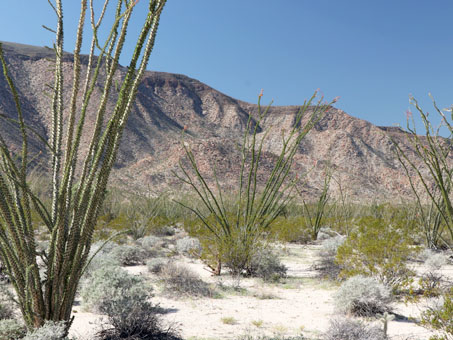
Ocotillo, Creosotebush / Gobernadora (Larrea tridentata, Zygophyllaceae) and White Bur-sage are the dominant plants here. This from late January 2020.
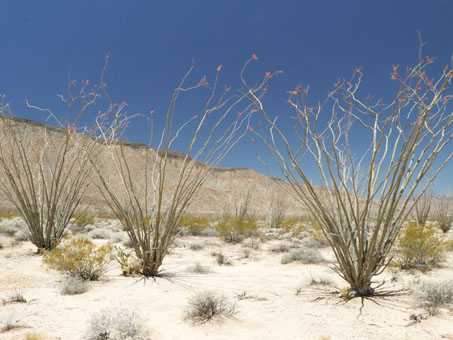
Same location and view in mid May 2020. The annuals that had carpeted the ground were gone.
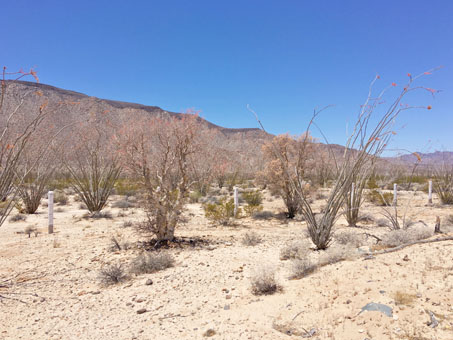
The Elephant Trees/Copalquín or Torote Blanco (Pachycormus discolor var. pubescens, Anacardiaceae) in this location were just beginning to bloom.

In January, the ground here was covered with poppies, Cryptanthas, & other tiny annuals, and the Elephant Trees were covered with leaves.

Elephant Tree/Copalquín buds. The flowers are dark pink.
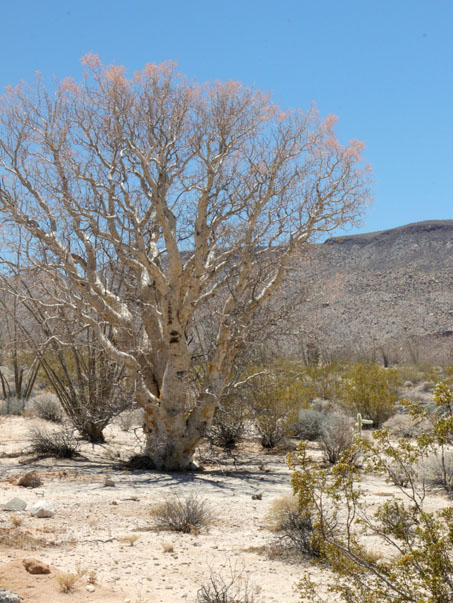
The first signs of this species' rosy blush.
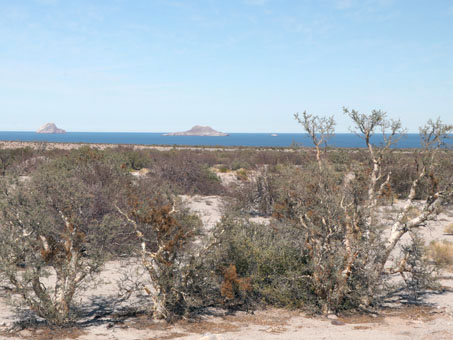
Elephant trees from Jan. 2020. Copalquíns are in the foreground with Torote Prieto (Bursera hindsiana, Burseraceae) the reddish plants behind.
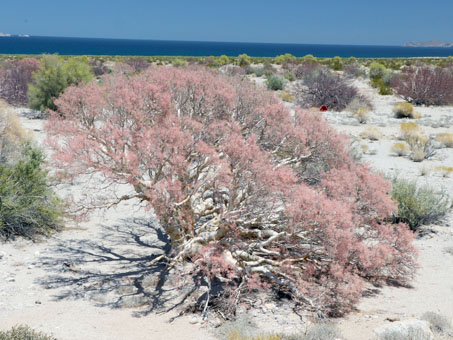
Copalquín in full bloom in the same area in mid May 2020. Some Palo Verde / Dipúa (Parkinsonia microphylla) trees in the background are now green and showing signs of flowers.
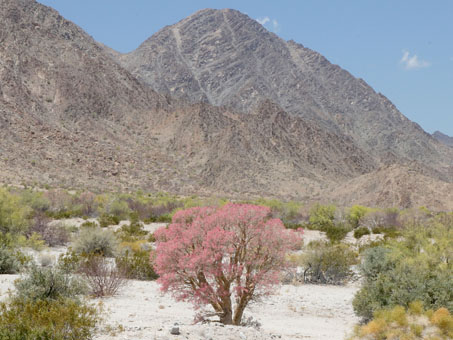
A spectacular example of Copalquín. Some trees are pale pink, like in the previous image, while others like this are quite intense.
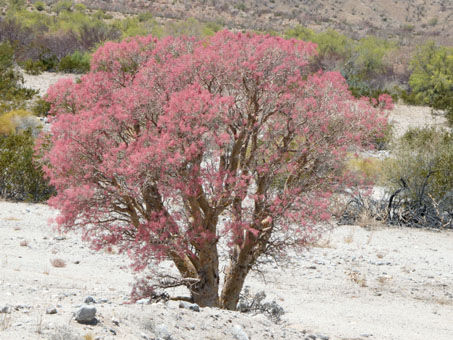
Closer view of the same tree.
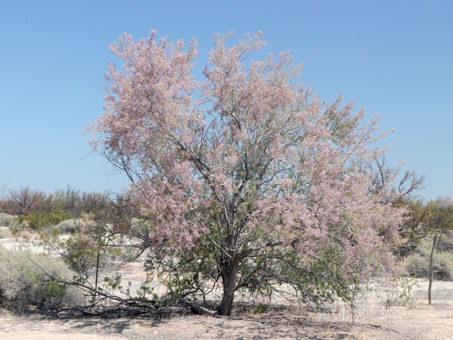
Desert Ironwood / Palo Fierro (Olneya tesota, Fabaceae) in all its glory. The pinkish flowers of both this species and Copalquín dominated the desert colorscape to well north of San Felipe.
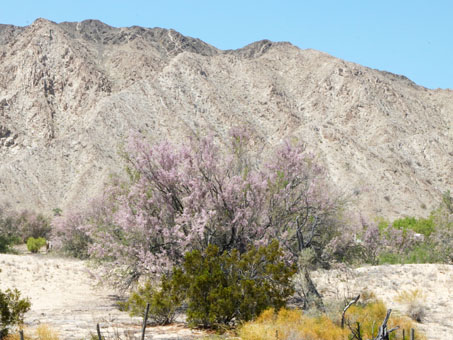
From a distance and against a gray or light backdrop, the flowers of a sparsely-leaved Desert Ironwood can almost become invisible.
Hwy 5 — Km 102 Upper Gulf of California & the Colorado River Delta (at Cucupah)
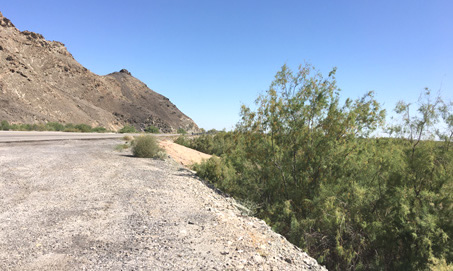
Not much farther north, the highway passes alongside the river delta at the base of the arid mountains. Here near Cucupah, a channel was filled with Cattails, reeds, Saltcedar (Tamarix ramosissima) and birdlife.
That's it for this month and sadly for this season. I hope to be back soon with some new Baja California adventures, but when that will be is still up in the air. Hopefully, sooner than later. So until then, hasta pronto...
Debra Valov—Curatorial Volunteer
References
[1] Minch, J. A., E. Minch, and J. Minch. 1998. Roadside geology and biology of Baja California. J. Minch and Associates, Mission Viejo, CA. [back to text]
[2] Hasenstab-Lehman, ...M. Weigeng. 2016. Familial classification of the Boraginales. Taxon 65:502–522. [back to text]
Rebman, J. P., J. Gibson, and K. Rich, 2016. Annotated checklist of the vascular plants of Baja California, Mexico. Proceedings of the San Diego Society of Natural History, No. 45, 15 November 2016. San Diego Natural History Museum, San Diego, CA. Full text available online.
Rebman, J. P and Roberts, N. C. (2012). Baja California Plant Field Guide. San Diego, CA: Sunbelt Publications. Descriptions and distribution.
Wiggins, I. L. (1980). The Flora of Baja California. Stanford University Press. Keys and descriptions.






